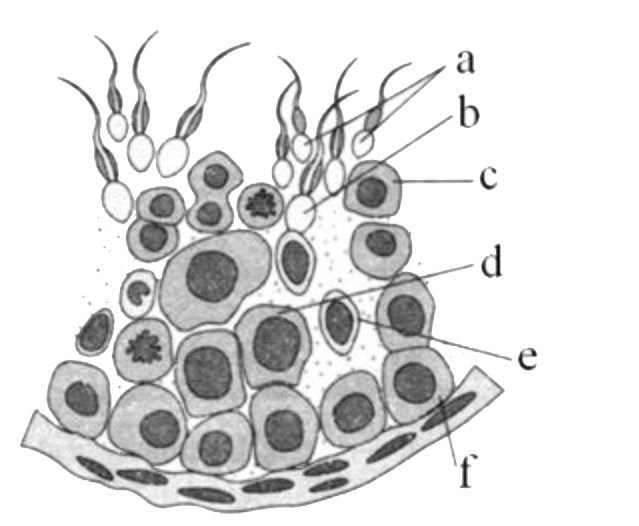Primary spermatocyte differs from spermatogonium in
Number of chromosomes
size and volume
DNA content
Size of chromosomes
The correct Answer is:B
To understand how primary spermatocytes differ from spermatogonia, we can break down the differences step by step:
1. Definition of Spermatogonium:
- Spermatogonia are the germ cells that are the precursors to sperm cells. They are diploid (2n) cells, meaning they contain two sets of chromosomes.
2. Process of Development:
- Spermatogonia undergo mitotic division. During this process, one of the resulting cells grows larger and becomes a primary spermatocyte.
3. Definition of Primary Spermatocyte:
- A primary spermatocyte is also a diploid (2n) cell, similar to spermatogonia. However, it is the first stage in the process of meiosis, where it will eventually divide to form haploid spermatids.
4. Comparison of Size:
- The primary spermatocyte is larger than the spermatogonium. This increase in size occurs because the primary spermatocyte absorbs more nutrients and grows in volume.
5. Chromosome Number:
- Both spermatogonia and primary spermatocytes have the same number of chromosomes (2n), so this is not a distinguishing factor.
6. DNA Content:
- The DNA content remains the same between spermatogonia and primary spermatocytes, as both are diploid.
7. Conclusion:
- The primary difference between a primary spermatocyte and a spermatogonium is the size and volume. The primary spermatocyte is larger due to nutrient absorption and growth.
Final Answer:
Primary spermatocyte differs from spermatogonium in size and volume.
---
- Spermatogonia are the germ cells that are the precursors to sperm cells. They are diploid (2n) cells, meaning they contain two sets of chromosomes.
- Spermatogonia undergo mitotic division. During this process, one of the resulting cells grows larger and becomes a primary spermatocyte.
- A primary spermatocyte is also a diploid (2n) cell, similar to spermatogonia. However, it is the first stage in the process of meiosis, where it will eventually divide to form haploid spermatids.
- The primary spermatocyte is larger than the spermatogonium. This increase in size occurs because the primary spermatocyte absorbs more nutrients and grows in volume.
- Both spermatogonia and primary spermatocytes have the same number of chromosomes (2n), so this is not a distinguishing factor.
- The DNA content remains the same between spermatogonia and primary spermatocytes, as both are diploid.
- The primary difference between a primary spermatocyte and a spermatogonium is the size and volume. The primary spermatocyte is larger due to nutrient absorption and growth.
Primary spermatocyte differs from spermatogonium in size and volume.
Topper's Solved these Questions
Similar Questions
Formation of primary spermatocyte/ oocyte from a spermatogonium/oogonium requires
View SolutionDraw a labelled diagram of the sectional view through a small part of seminiferous tubule of testis and label Sertoli cells, primary spermatocytes, spermatogonium and spermatozoa.
View SolutionDraw a diagrammatic sectional view of a human seminiferous tubule, and label sertoli cells, primary spermatocyte, sperm-atogonium and spermatozoa init.
b) Explain the hormonal regulation of the process of spermatogenesis in humans.
View SolutionRecognize the figure and find out the CORRECT labeling.

(a) a -spermatozoa, b - spermatid, c - primary spermatocyte , d - secondary spermatocyte , e - spermatogonia , f - sertoli cell
(b) a -spermatozoa, b - spermatid, c - secondary spermatocyte , d - primary spermatocyte - Sertoli cell , f - spermatogonia
(c) a -spermatozoa, b - spermatid, c - primary spermatocyte , d - secondary spermatocyte , e - spermatogonia , f - sertoli cell
(d) a -spermatozoa, b - spermatid, c - secondary spermatocyte , d - primary spermatocyte - Sertoli cell , f - spermatogonia
View SolutionHow many secondary spermatocytes will form 400 spermatozoa :-
View SolutionAssertion: The type B spermatogonia are called primary spermatocytes.
Reason: Primary spermatocytes complete the first meiotic division leading to secondary spermatocytes.
View SolutionAssertion : Primary spermatocytes of testes are haploid .
Reason : Primary spermatocytes are formed by meiosis I in the spermatogonia .
View SolutionCorrect sequence of spermatogenesis :
(a) spermatogonia
(b) spermatids
(c) primary spermatocyte
(d) secondary spermatocyte
(e) spermatozoa
View SolutionIn spermatogenesis, a primary spermatocyte produce four similar sperms while in oogenesis a primary oocyte forms
View SolutionA spermatogonial cell has 30 chromosomes. How many chromosomes will be found in (i) the primary spermatocyte, (ii) a spermatid derived from this cell?
View Solution
